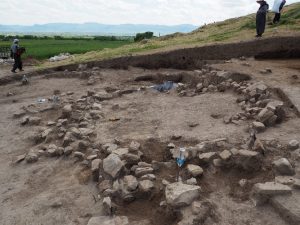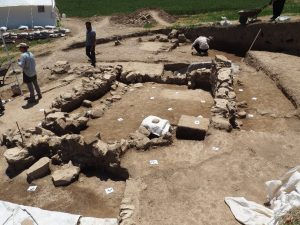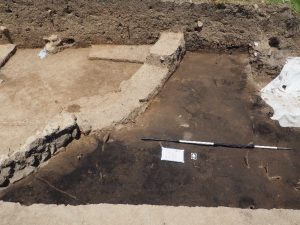Lisa Cooper (Director of the UBC archaeological team at Bestansur)
Our fascinating archaeological work was carried out in April-May 2019 at the site of Bestansur, located in the Sulaymaniyah Province of Iraqi Kurdistan. Working under the aegis of the Central Zagros Archaeology Project, directed by Reading University professors Roger and Wendy Matthews, and funded by a SSHRC Insight Development Grant, we continued to reveal material culture that aids in our understanding of the Neo-Assyrian presence at the site and surrounding region (c. 7th century BCE). This year, our focus also turned to later Sasanian period remains at the site (c. 3rd to 6th centuries CE), and the impact and significance of occupation from this time. Our UBC archaeological team included Lisa Cooper (Professor of Near Eastern Archaeology), Kathryn Kelley (CNERS Postdoctoral Fellow), and Amber Leenders (CNERS MA student). Lynn Welton, a Marie Curie Postdoctoral Fellow in the Department of Archaeology at Durham University and former SSHRC postdoctoral fellow at UBC was also a member of the UBC team and supervised the excavations of one of the two trenches. The faunal materials from the UBC excavations were studied by Dr. Jill Weber (U. Penn) while archaeobotanical samples were the subject of investigations by Dr. Charlotte Diffey (Reading University). Excavations benefitted greatly from the assistance of a work force from the village of Bestansur, and from the project’s Iraqi government representatives, Kemal Raouf Aziz and Sami Jamil Hama Rashid.
The UBC team’s efforts were concentrated in two areas on the mounded tell of Bestansur, characterized by post-Neolithic period archaeological remains. The areas consisted of Trench 10W, located on the eastern side of the tell directly west of Trench 10 proper (where the excavations of the CZAP team have carried investigations down to Neolithic period levels) and Trench 10N, directly to the north of Trench 10. Briefly, the excavations in Trench 10W revealed a series of small stone structures built up against the sloping eastern side of the mound. In their latest preserved phase, the structures were identified as having curvilinear forms, these representing the last phase of re-use of earlier and more substantial domestic constructions (fig. 1). In these latest phases, however, their ephemeral construction, along with the fact that they did not bear traces of clear occupational surfaces or domestic installations, suggest that they were not used for human habitation. Rather, based on their similarities in form and dimensions to round structures identified from satellite imagery from the steppe region of north-western Iran, known to have been the pasture grounds of several pre-modern tribal groups, these could represent the enclosures of semi-sedentary pastoral groups who used the structures to pen temporarily their flocks of sheep and goats. Samples were taken of the deposits from within these structures in their later phases, and preliminary spot samples confirmed the presence of dung spherulites, consistent with the penning of animals.
The curvilinear structures of Trench 10W proved to be the latest of a sequence of stone structures that were constructed in this particular sector of the site (fig. 2). That the buildings were in use over a more or less continuous period of time is indicated by the re-use and continued modification of their stone walls throughout the sequence, along with a series of superimposed, stamped earth or lightly cobbled surfaces. An elaborately constructed clay tannour – equipped with a flue near its base and set into a pebbled platform – was constructed in one of the building’s earliest phase and was associated with two or three phases of use within the one of the buildings (fig. 3). Such fire installations may indicate a domestic use for this building in its earlier occupations, thereby possibly attesting to its transformation from a domestic residence for human groups to a later function as a temporary enclosure for animals.


Fig. 1: Late curvilinear phase of Central Building


Fig. 2: Earlier rectilinear phase of Central Building


Fig. 3: Tannour with flue in earlier phase of Central Building
Preliminary observation of the pottery from these Trench 10W contexts suggests that much of the occupation of these structures took place during the Sasanian period (3rd-7th centuries CE), and possibly extending into the subsequent early Islamic period (7th-8th centuries CE). Tannours (particularly on the south-eastern side of trench) in Trench 10W encountered outside of the Central and North-East Buildings may prove to date even later, up to the Ottoman period of the recent past.
Excavations in the nearby Trench 10N included ephemeral Sasanian period structures and installations, while further down, a large ‘Burned Building’ was encountered. The interior of the Burned Building has thus far been identified to have experienced two major burning events, attested by layers of broken chunks of burned orangey-red or dark brown mud and ash. Analyses of spot samples of these deposits revealed phytoliths of reeds, consistent with the suggestion that much of this burning represented roofing material of mud plaster and reed matting that had burned and collapsed during the conflagration of the building (fig. 4). The burning of this phase was heavy enough to scorch the interior face of one of the stone walls of the building, leaving many stones smoke-blackened, and turning the surface of the inner face of the pisé wall into an orange crusty layer.


Fig. 4: Charred deposit of later phase of Burned Building
Directly below this burned layer was the floor, this being the latest of several surfaces, each distinguished by a thin, pale grey-coloured, horizontally deposited layer of flooring material.
The lack of good diagnostic pottery from the Burned Building has made a precise date for its occupation and destruction difficult to establish, although judging from what meagre sherds were found, it is suggested to date to the Iron Age. It is conceivable that the destruction events in the Burned Building are contemporary with the destruction by fire of the structures encountered in Trench 14 in 2013 and 2017 to the south-east of the mound, where abundant pottery forms attest to occupation from the 7th century BCE.
In all, this was a productive season of excavations. On our days off, we enjoyed the opportunity to travel through the countryside of the Sulaymaniyah Province of Iraqi Kurdistan. In April, the hills and mountain ranges are stunningly beautiful, and they hold within them ancient tell-sites, petroglyphs and rock reliefs (e.g. that of Naram-Sin at Daband-i-Gawr and the iconic Neolithic site of Jarmo) that span thousands of years of human habitation.


